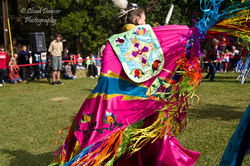

cultural advocacy
I am half Native American. My dad is full-blooded. My mom is German and Irish. I grew up in the Waccamaw-Siouan tribal community of southeastern North Carolina, actively participating in my tribe’s customs. I have worn regalias and danced in powwows, practicing, learning, and embodying Native American culture since before I can remember. It is a vital aspect of my life. It is who I am as an individual and thereby directs my personal interests.
Personal archive. Cultural interchange. Dance as dialogue.
 |  |  |  |
|---|---|---|---|
 |  |  |  |
 |  |
The Misrepresentation of Native American Culture: What is the Line?
Paper presented at the Society of Dance History Scholars and the Congress on Research in Dances' 50th Anniversary Conference – “Beyond Appropriation and Authenticity” at Pomona College in Claremont, CA.
November 5, 2016
Within the dance field, it has been understood that appropriation exists. Choreographers such as Jiří Kylián and Abbey Lee Miller regularly ‘borrow’ from other cultures, using their movement aesthetics, customs, and ritualistic beliefs as inspiration for art. What is under debate is the context in which appropriation can and does occur. How does it exist? What are the stipulations? Are their negative and positive impacts? Is there an ethical way to appropriate a culture ‘respectfully’? This paper will discuss the use of Native American culture for choreographic inspiration in a performance setting, analyzing the methodologies used and determining ways to lessen the negative affects of appropriation. Topics like film industry involvement, mascot development, Wild West show impacts, sports teams influence, and significance of commercialization will be addressed to substantiate the author’s findings. Comparisons will be drawn between ‘playing Indian,’ interpreting Indian, and representing Indian culture implicitly and explicitly as an effort to differentiation perspectives in hopes of finding possible solutions to the ethical perspective of cultural appropriation.
Inspiration or Appropriation - What is the Line? : The Ethics and Perspectives
Paper presented for Scholar's Day at The College at Brockport in Brockport, NY.
April 6, 2016
Inspiration and Appropriation are two terms that describe a similar process but have two different outlooks, especially in the dance field. Choreographers often utilize outside sources as the basis of their artistic work, generating movement and creating spatial relationships around bodies they have observed or encountered, often subjecting them to issues of authenticity and appropriation. The term appropriation has obtained a negative connotation associated with misrepresenting a culture and skewing the public’s perception of that culture through inaccurate depictions. Whereas, using a culture as inspiration for creative work is perfectly acceptable and encouraged. So what then is the distinction between the two terms? What are the parameters? How is appropriation differentiated from inspiration? This paper will attempt to distinguish the ethics and perspectives of each term by analyzing and comparing instances in which Native American and Hip Hop culture have been used in dance.
Daystar: Indigenous Dance and Storytelling
Lecture Demonstration at the Central Library of Rochester and Monroe County in Rochester, NY.
January 9, 2016
Performed along side Daystar (Rosalie Jones), world renown Native American artist and scholar. In 1980 she founded the first native modern dance company Daystar: Contemporary Dance-Drama of Indian America. She continues to teach the curriculum she developed for Indigenous Performance Studies at Trent University. The performance was the second installment of the library's "Bodies in Motion" series and introduced audiences to ancient and contemporary dance-drama of Native American culture. Along with performances of the Jingle and Fancy Shawl dances, traditional stories like "Wolf: the First Companion of First Man" were shared. The program was free and open to all ages and encouraged everyone to participate and learn some of the dances.
Missy Elliott versus Ephrat Asherie: The Battle for Acceptance in Hip Hop Culture
Paper presented for Scholar's Day at The College at Brockport in Brockport, NY.
April 8, 2015
Does one have to be born into a particular culture to represent that culture accurately? Hip Hop is an area rooted in identity and community. The ability to embody the essences of hip hop aesthetic is to understand the struggle and obstacles that hip hop emerged from. How then can a person represent and perform this style without having lived in the “hip hop” era? What gives one dancer the credibility to perform a dance style versus another? Does being born in a culture give one access and privilege versus choosing it? When does training and ability make a difference? So much of what a person values is based on appearance and stereotypical norms; experience and personal investment is never considered. Society bases an individual's successful portrayal of a dance genre on whether a person fits all of the criteria they associate with that cultural dance form, in this case hip hop dance. This paper compares hip hop artist Missy Elliott and b-girl Ephrat “Bounce” Asherie to determine whether one artist embodies the hip hop dance form more successfully than the other and what factors contribute to their acceptance within hip hop culture.


